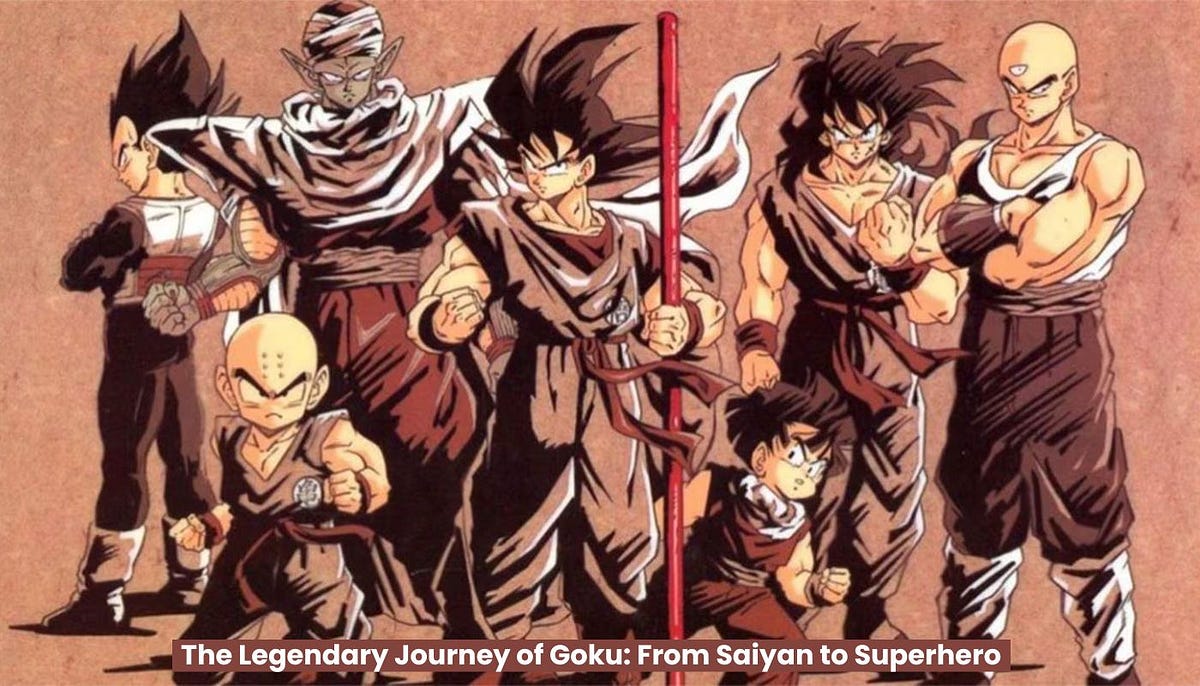In the world of manga and anime, few names are as synonymous with success and influence as Akira Toriyama. Born on April 5, 1955, in the town of Kiyosu, Aichi Prefecture, Japan, Toriyama would grow up to become a defining figure in the industry, creating works that resonated with millions around the globe. His journey from a young boy fascinated by animation and illustration to a celebrated manga artist is a tale of passion, perseverance, and the power of storytelling.
Toriyama’s early life was marked by a profound love for drawing
A passion ignited by his exposure to Disney’s ‘One Hundred and One Dalmatians’ and the manga collection of a classmate’s brother. These experiences, coupled with his admiration for Osamu Tezuka’s ‘Astro Boy’, laid the foundation for his future in the arts. Despite a brief hiatus from manga during his middle school years, Toriyama’s talent and interest in the medium never waned. His high school years, focused on creative design, further honed his skills, even as he prioritized fun with friends over academic pursuits.
Upon graduation, Toriyama entered the workforce, taking a job at an advertising agency in Nagoya. However, the constraints of a routine job and his casual approach to work life led to dissatisfaction, prompting him to leave the agency after three years. It was a bold move that would steer him towards his true calling: manga.
Toriyama’s break into the manga industry came after he submitted a work to an amateur contest in Kodansha’s Weekly Shōnen Magazine. Although his initial submission was not eligible for competition, it caught the attention of Kazuhiko Torishima, who would become his long-time editor. Encouraged to continue drawing, Toriyama’s first published work, ‘Wonder Island’, appeared in Weekly Shōnen Jump in 1978. Despite a rocky start, with his early works not garnering much success, Toriyama’s persistence paid off when he created ‘Tomato the Cutesy Gumshoe’, followed by the wildly successful ‘Dr. Slump’.
‘Dr. Slump’, serialized from 1980 to 1984, was a comedic hit that followed the misadventures of a quirky inventor and his robot creation, Arale. The series not only earned Toriyama the 1981 Shogakukan Manga Award but also became a cultural phenomenon, spawning a successful anime adaptation and selling over 35 million copies in Japan. Toriyama’s desire to end ‘Dr. Slump’ after a short run was met with resistance from his publisher, but a compromise was reached, leading him to work on various one-shots and eventually setting the stage for his most iconic work: ‘Dragon Ball’.
‘Dragon Ball’ began as a serialized manga in Weekly Shōnen Jump in 1984 and quickly evolved from an adventure-comedy into a martial arts epic. The series was inspired by Toriyama’s love for kung fu films and his earlier works like ‘Dragon Boy’. Over the course of its 519-chapter run, ‘Dragon Ball’ became a cornerstone of the manga industry, influencing countless artists and captivating audiences worldwide. Its success was not limited to print; the anime adaptations further propelled the series to international fame, contributing to the global rise of anime.
Toriyama’s work ethic and creativity during this period were remarkable. Even as ‘Dragon Ball’ demanded a significant portion of his time, he continued to contribute to other projects, including character design for the ‘Dragon Quest’ video game series and the RPG ‘Chrono Trigger’. His influence extended beyond manga and anime, as he ventured into video game design and even contributed to the creation of an electric car.
The impact of Akira Toriyama’s work is immeasurable. ‘Dragon Ball’, in particular, stands as a testament to his storytelling prowess and artistic vision. It’s a series that has transcended cultural barriers, inspiring a generation of artists and entertaining fans across the globe. Toriyama’s legacy is not just in the characters and worlds he created, but in the joy and inspiration he brought to millions. As we delve deeper into the phenomenon of ‘Dragon Ball’, we’ll explore how a series originally intended to end after just 19 chapters grew into a 519-chapter juggernaut that continues to resonate with fans to this day.
The Dragon Ball Phenomenon: How a Short Series Became a Global Sensation
When Akira Toriyama embarked on the journey of creating ‘Dragon Ball’, little did he know that he was about to pen down what would become a cornerstone of not just manga, but global pop culture. Originally planned to conclude after the dragon balls were collected, which occurred in chapter 19, ‘Dragon Ball’ defied all expectations by continuing for a staggering 519 chapters. This section delves into the evolution of ‘Dragon Ball’ from a short series to a global sensation, exploring the factors that contributed to its enduring success and the legacy it has left behind.
‘Dragon Ball’ began serialization in Weekly Shōnen Jump in 1984, and it was clear from the onset that Toriyama had struck a chord with readers. The series, inspired by the classic Chinese novel ‘Journey to the West’, initially followed the adventures of the monkey-tailed boy Goku as he sought the dragon balls, which, when gathered, could summon a dragon capable of granting any wish. The blend of humor, unique characters, and a world rich with fantasy and adventure captivated audiences. However, it was the shift from adventure-comedy to a more action-packed martial arts saga that truly catapulted ‘Dragon Ball’ to new heights.
The introduction of the World Martial Arts Tournament and the focus on Goku’s growth as a martial artist brought a new level of excitement and depth to the story. Battles became more intense, stakes were raised, and characters developed in complexity. Toriyama’s ability to continually introduce intriguing characters and inventive power-ups kept the series fresh and the readers hooked. The serialized format allowed fans to grow with the characters, sharing in their triumphs and setbacks, creating a bond that would span generations.

The success of the manga inevitably led to anime adaptations, which further expanded ‘Dragon Ball’s reach. The original ‘Dragon Ball’ anime and its successor, ‘Dragon Ball Z’, became global phenomena, capturing the imaginations of viewers around the world. The anime’s success was bolstered by its memorable soundtrack, voice acting, and dynamic fight sequences, which translated Toriyama’s art into vibrant, action-packed animation. The anime adaptations played a pivotal role in introducing anime to Western audiences, laying the groundwork for the medium’s popularity outside of Japan.
Merchandising also played a significant role in ‘Dragon Ball’s success. From action figures and video games to clothing and home decor, the ‘Dragon Ball’ brand became ubiquitous. The series’ appeal was so broad that it transcended age groups and demographics, becoming a staple in the lives of children and adults alike. The global community of ‘Dragon Ball’ fans is a testament to the series’ universal themes of friendship, perseverance, and the enduring spirit of adventure.
Toriyama’s involvement in other projects, such as the ‘Dragon Quest’ series and ‘Chrono Trigger’, showcased his versatility and further cemented his status as a creative force. His distinctive art style and character designs became instantly recognizable, influencing a new generation of artists and creators. The impact of ‘Dragon Ball’ on the manga and anime industry is profound, with many contemporary manga artists citing it as a major source of inspiration.
In 2019, Toriyama’s contributions to the arts were recognized when he was decorated a Chevalier of the French Ordre des Arts et des Lettres. This honor highlighted not just the commercial success of his works, but their cultural significance and the joy they have brought to countless fans worldwide.
The legacy of ‘Dragon Ball’ is multifaceted. It is a series that has been continuously celebrated through various remastered releases, new animated series like ‘Dragon Ball Super’, and a steady stream of video games that allow fans to relive and expand upon their favorite moments. The story of Goku and his friends has become a cultural touchstone, a shared language among fans across the globe.
‘Dragon Ball’s transformation from a series that was intended to end after a mere 19 chapters to a 519-chapter epic is a narrative of perseverance, creativity, and the power of storytelling. Akira Toriyama’s vision created a world that resonates with millions, a world that continues to inspire and entertain. ‘Dragon Ball’ is more than just a manga or anime; it is a phenomenon that has shaped the landscape of entertainment and will continue to do so for years to come.
Related posts:
Akira Toriyama
Intended Endings Guide
20 years ago today, the original Dragon Ball Manga ended





